A History of the County of Buckingham: Volume 3. Originally published by Victoria County History, London, 1925.
This free content was digitised by double rekeying. All rights reserved.
'Parishes: Great Marlow', in A History of the County of Buckingham: Volume 3, ed. William Page( London, 1925), British History Online https://prod.british-history.ac.uk/vch/bucks/vol3/pp65-77 [accessed 15 January 2025].
'Parishes: Great Marlow', in A History of the County of Buckingham: Volume 3. Edited by William Page( London, 1925), British History Online, accessed January 15, 2025, https://prod.british-history.ac.uk/vch/bucks/vol3/pp65-77.
"Parishes: Great Marlow". A History of the County of Buckingham: Volume 3. Ed. William Page(London, 1925), , British History Online. Web. 15 January 2025. https://prod.british-history.ac.uk/vch/bucks/vol3/pp65-77.
In this section
GREAT MARLOW
Merelafan, Merlaue (xi cent.).
The whole ecclesiastical parish of Great Marlow, to which Ackhampstead in Lewknor-up-Hill, Oxon., was added by Local Government Board Order in 1885, was divided for civil purposes into two parishes by a further Local Government Board Order (fn. 1) which came into operation 1 October 1896. One of these, comprising the area of the urban district, was known as Marlow (Urban) and the other consisted of the remainder of the old civil parish, including Bovingdon Green, Harleyford, Lane End, &c., called Great Marlow. By another order (fn. 2) which came into operation at the same date part of the former civil parish of Great Marlow, now called Marlow Urban, was constituted an urban district by the name of Great Marlow. This was altered to that of Marlow by order of the County Council 11 February 1897. (fn. 3) Under the Local Government Act of 1894 a council of nine members governs the urban district and the regulation of Great Marlow parish affairs is vested in a parish council consisting likewise of nine members.
The area of the urban district is 968 acres, of which 28 acres are covered with water, (fn. 4) 105 are arable land and 431 grass. (fn. 5) Great Marlow parish comprises 5,706 acres of land, 26 of land covered by water, and has 2,505 acres under the plough, 1,612 laid down in permanent grass and 846 covered by woods and plantations. (fn. 6) The soil in general consists of flint, chalk, gravel and loam with a varied subsoil.
The land, which is throughout well wooded, falls from a height of 600 ft. in the extreme north-west at Lane End to under 100 ft. above the ordnance datum in the south, where the River Thames marks the southern boundary. Marlow grew up on the banks of the river, and probably owed its importance to its position on the high road between Reading and High Wycombe, the connexion between which towns is secured by the bridge, formerly of timber, for the repair of which an indulgence was granted as early as 1294. (fn. 7) Leland refers to it about 1535. (fn. 8) It suffered during the Civil War, and was partly destroyed in 1644, when Major-General Brown and his soldiers were quartered in the church, about which they threw up bulwarks. (fn. 9) Another bridge of wood was built by subscription in 1789, (fn. 10) but was superseded in 1831 by the present suspension bridge, erected at a cost of £22,000. The old bridge crossed the river at the end of St. Peter's Street (formerly Duck Lane), but the suspension bridge is placed higher up the river in line with the High Street.
The erection of the bridge and the convenience of Marlow as a place of call probably led to the grant of a market, and this became a centre for the surrounding country. The proximity of the river was also a great asset to mediaeval Marlow, which placed its church on the bank near the bridge; but the town did not develop along these low-lying grounds, but extended northwards and upwards on the more healthy parts. The value of the river as a pleasure resort and the beautiful views to be obtained of the Berkshire side have led, however, in modern times to the erection of several houses, which succeed one another along the bank, their lawns sloping down to the water-side. The swans which frequent these reaches of the river were at one time a source of profit, and numerous grants of their custody were made by the Crown in the 15th century. (fn. 11) The swans with the right to a 'Swanne marke' were specially mentioned in the grant of the manor to Lord Paget in 1554, (fn. 12) and a game of Swans on the Thames and the marks belonging to it were bequeathed in his will by John Sandes of Great Marlow to Henry his son in 1555. (fn. 13) By the 19th century the ownership of the swans was vested in the king and in the Dyers' and Vintners' Companies, which still send swanhoppers every year to count and mark them. (fn. 14) Attached to the manor were the right of free fishing and a ferry across the Thames. (fn. 15) Private wharves, too, were of considerable value. (fn. 16)
There was formerly an old building near the bridge, now destroyed, known as the Conventual Barn of Bisham Abbey. It was used as a prison for Frenchmen during the war, and was turned into a coal dépòt about the middle of the 19th century. (fn. 17) It was pulled down in 1878, but the bulk of the timbers of the roof were re-used in the new church at Lane End.
The vicarage, close by the church in the Causeway, is a compact well-built house erected in 1863 from the designs of the late Mr. G. E. Street. It stands on the site of a picturesque 16th or early 17th-century inn, 'The Swan.' The previous vicarage was a small house on the east side of High Street, referred to in the early 19th century, (fn. 18) and succeeded one on the west side. The old parsonage-house, behind the church in St. Peter's Street, still exists, however, and is at present the residence of Mr. W. Morgan. It was built late in the 14th century, and, though partly rebuilt in the 17th century and much enlarged at a later date, it still retains the hall of the original house. The north and south walls of this hall each have an original window of two trefoiled lights with tracery under a square head and the truss of the original roof also remains. Other 14th-century features are now reset in parts of the house, which also contains a large amount of good carved 17th-century panelling and the upper part of a staircase of the 17th century. Part of the old parsonage-house, now an entirely separate building, the residence of Lady Frances Legge, is called the Deinery, from confusion between the name of the former owner (Deane) and the modern Roman Catholic convent close by.
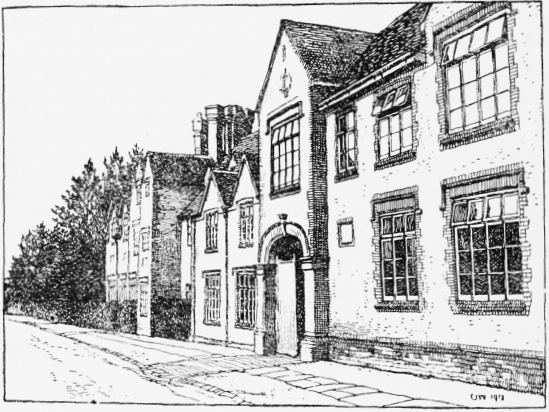
Borlase School, Great Marlow
At the head of St. Peter's Street, facing south, is Marlow Place. Once the property of the Farmer family, it passed to the Borlases and was inherited by Alice daughter and co-heir of William Borlase, who brought it in marriage to John Wallop, the owner in 1690. (fn. 19) He is said to have built the present house, which was occupied from 1720 to 1751 by George II when Prince of Wales. (fn. 20) It is a stately house of brick three stories in height with attics and red-tiled roofs. In the early 19th century it was used as a hostel of the Military College, and later, on the removal of the college to Sandhurst, was used as a boarding school. (fn. 21) It is now the property of Mrs. Owen Williams and occupied by Mr. William Niven, F.S.A., J.P.
The Roman Catholic chapel in St. Peter's Street, a small but beautiful building of flint and stone after the designs of the elder Pugin, was founded by the late Mr. C. R. Scott-Murray in 1846. (fn. 22) Near to it are the school and school-house built from the design of the younger Pugin. Opposite the chapel is the public hall and near the bottom of the street is the 'Fisherman's Retreat,' an inn much resorted to by anglers.
The High Street is fairly wide and contains several old houses of good appearance, but all refronted with the exception of the butcher's shop in the middle of the west side. It opens at the north end into the so-called market square, formed by its junction with West and Spittal Streets, which run at right angles. Here is the town hall, a building of stone, with turret and clock, erected in 1807 on the site of the market hall which Langley describes at the end of the 18th century as 'a very old miserably heavy building of timber.' (fn. 23) Adjacent to it is the Crown Hotel, which with the market-house and manor passed in 1735 to the Claytons. (fn. 24) They also acquired at that date the 'Bear' and a malt-house, formerly the 'Black Boy.' (fn. 25) The latter building, of 16th-century or probably older date, was in Church Passage and was pulled down in 1870 when the passage was reduced to an alley. (fn. 26)
In Spittal Street are a Wesleyan chapel, rebuilt in 1901, and the Greyhound Hotel. The name of the street probably points to the location here of the hospital of St. Thomas, which was in great poverty in 1384, when licence was obtained by the master and brethren to acquire property to the value of 100s. a year. (fn. 27) Spittal Street is continued west as West Street, one of the older portions of the town. Here is the Borlase school, founded in 1624, in memory of his 'good son' Henry, by Sir William Borlase, as a free school for twenty-four boys. (fn. 28) The almshouses in Oxford Lane were originally founded by John Brinkhurst of the More (Moor Farm, Lane End) in 1608 and added to by James Rolls in 1874. (fn. 29) A two-storied building in West Street arrests the attention by an inscription on the parapet to the effect that the poet Shelley once lived here. The house, now divided into three cottages, is a long, low structure of simple proportions covered by climbing plants. Shelley was induced to settle here by a visit to Thomas Love Peacock at Marlow in 1816, and spent the greater part of 1817 in this house, where he composed 'The Revolt of Islam.' (fn. 30) Opposite Shelley's house is Remnantz, a fine 18th-century house of red brick with a stable block and clock tower of admirable design. It is the property of Mr. Thomas Owen Wethered, J.P., of Seymour Court, whose family has been settled in Marlow for about 150 years. George Wethered, son of Edward and Susannah Wethered of Penn, moved to Marlow, where he died in 1783, leaving a son Thomas. (fn. 31) He acquired Remnantz, which had been occupied by the Royal Military College from its establishment at Marlow in 1799 to its removal in 1811, and is described as of Remnantz at his death in 1849. (fn. 32) He left a widow Sarah and a son Owen who died in 1862. At the death of his widow in 1881 Remnantz descended to their son, the present proprietor. The old-established brewery of Messrs. Thomas Wethered & Sons, Ltd., stands a little to the south, with the entrance in High Street.
On the western outskirts of the town are several other good houses standing in their own grounds, among them Spinfield, the residence of Mrs. Robert Hay Murray. It is a fine red brick building in the Italian style with beautiful gardens, whence extensive views over the river valley are obtained. Highfields, in the same advantageous situation, is the recentlybuilt seat of Mr. A. L1. Griffith-Williams. The house called Gyldernscroft, formerly known as Townsend Cottage (after a family of that name), and later The Croft, incorporates the walls of a 16th-century building. It was once the property of the Pagets and afterwards of the Langleys. It was bequeathed by the historian to the family of the present owner, (fn. 33) Gen. Sir George W. A. Higginson, G.C.B., who came into possession on the death of his father, Gen. Sir George Powell Higginson, in 1866. (fn. 34)
West of Highfields is Beechwood, the property of the trustees of the late Mr. R. S. B. Hammond-Chambers, K.C., who built the new house. The house stands in well-wooded grounds on a height commanding a wide view towards the river. The old house near the Henley road was purchased in 1863 by Frank Smedley, the author of Frank Fairlegh, who died here the following year. (fn. 35)
In the north of the town is the poorer, more thickly-populated quarter served by Holy Trinity Church. Here are also the new Church of England boys' school, the cemetery and the police-court.
The station is a terminus on a branch from Bourne End of the Maidenhead and High Wycombe section of the Great Western railway, and is situated on the outskirts of the town to the south-east. There are many handsome villas and smaller bungalows along the banks of the river. To the east of the High Street is Thames Bank House, the residence of the late Mr. Thomas Somers Cocks, D.L., formerly M.P. for Reigate. He inherited the property from his father, to whom it was left by his sister, the widow of Vice-Admiral Sir James Nicoll Morris, K.C.B., the commander of the Colossus at Trafalgar, who died here. The house is now sold and let to summer visitors. Beyond is Thames Lawn, the residence of Mr. James Boyton, M.P. Beyond Thames Lawn are the Marlow paper-mills. To the west of the bridge is Sunny Bank, the residence of Mrs. Stanley Edwards, and north of this stands Court Garden, the seat of Mr. Robert Griffin, J.P. It was formerly the property of the Pagets and was sold by Henry Earl of Uxbridge in the middle 18th century to Dr. Battie, who built the house, a tall red brick building. (fn. 36) Dr. Battie died in 1776, (fn. 37) and his eldest daughter sold Court Garden to Richard Davenport, (fn. 38) Sheriff for Buckinghamshire in 1789. (fn. 39) At his death, ten years later, (fn. 40) the property passed to Davenport Bromley, who never lived there. (fn. 41)
About 2 miles west of the town on the river-bank is Harleyford House, the seat of Sir William Robert Clayton, bart. The original manor-house of the Pagets suffered greatly during the Civil War, and the present house was built near the site of the old one pulled down in 1755. (fn. 42) It is a red brick building in the Palladian style, designed by Sir Robert Taylor, (fn. 43) two stories in height with attics and a half basement; the drawing room walls are decorated with some good plaster-work. The house stands in the midst of well-timbered, park-like grounds, but its charm is in its gardens with lawns sloping down to the river.
The country round Marlow is exceedingly pretty and covered with beautiful beech woods. To the north-west of the town is the small hamlet of Bovingdon Green and beyond it stretches Marlow Common. Across the parish runs Marlow Bottom, one of the narrow, deep valleys so common in this county, which leads about 2 miles north of Marlow to the old farm-house of Munday Dean. The principal road north of Marlow leads to Oxford and rises continuously to Lane End, on the parish boundary. About 1 mile north of the town it passes Seymour Court, a square-built modern house and the seat of Mr. T. O. Wethered. The old house was practically destroyed in the Civil War, and portions of the garden wall were all that was left of it at the end of the 18th century. (fn. 44) The tradition that this house was the birthplace of Lady Jane Seymour, queen of Henry VIII, seems to have no foundation in fact; the Seymours who lived here before that date appear to have been an entirely distinct family. To the west of Seymour Court is Copy Green Farm. (fn. 45)
A mile beyond Seymour Court a lane leads west off the high road to Widmere Farm House, belonging to Sir William Clayton and occupied by Messrs. David White & Sons. The situation is a remarkably fine one, with beautiful views of the quiet country-side with its woods and valleys. Most of the farm-house is modern, but the chapel of the Hospitallers still exists. It adjoins the east end of the farm-house, of which it now forms a part. It is a rectangular building consisting of chapel with undercroft dating probably from the early 13th century, and appears to have been attached to a large building of that period. Windows were inserted in the south wall in the 14th century, and about 1600 the chapel was divided into two floors and converted into a dwelling-house. The building, which is roofed with tiles, is of flint and stone and the north and east walls are coated with roughcast. The undercroft, lighted by holes in the south wall, is vaulted in two aisles of four bays each, and has a central row of circular columns with plain capitals and bases and semicircular wall shafts with grooved capitals and high square plinths. The arches are segmental with chamfered edges, and the vault, probably of Totternhoe stone, is now thickly coated with whitewash. The chapel has a large early 14th-century window on the east, now blocked, above which is a vesica-piscis light. In the south wall are three 14th-century windows, the westernmost entirely blocked, while the other two have been blocked in the upper parts, their sills cut away and modern doorways inserted. Each of these was of two trefoiled lights with tracery above under a two-centred head. The tracery of the easternmost has been destroyed. In the north wall are two blocked 13th-century lancets and a modern window, and at the south-west is a 17th-century dormer. A blocked doorway and parts of windows built into the walls of an out-house on the west are probably re-used 15th-century work. The undercroft, which is said to be connected with Seymour Court by an under-ground passage, is now used as a dairy.
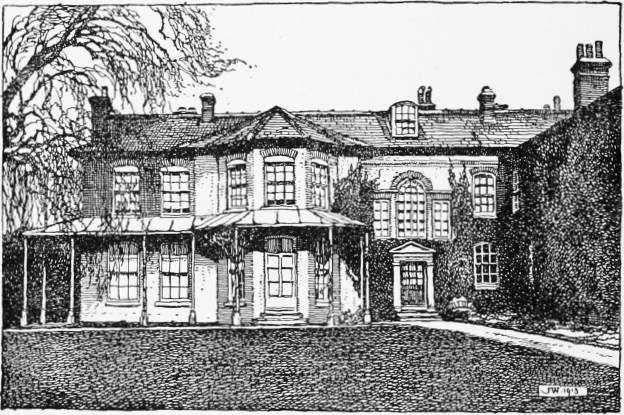
Remnantz, Great Marlow
Finnamore Farm, west of Widmere Farm, and the old workhouse in the south-east of the parish are both of 17th-century date, but the former has been much restored in modern times.
The country to the north of Marlow is chiefly under cultivation and there are many farm-houses scattered over the parish. Among them is the old farm-house of Homers with a fine cluster of chimneys, which lies on the eastern boundary about 3 miles north of Marlow. Oldhouse Farm, Hill, Burford and Lower Farms farm the land eastward of Marlow.
The road continuing north from Widmere skirts the woods called High Heavens and Hill Green, and leaving Beacon and Redbarn Farms on the left and Cutlers Farm on the right, reaches Lane End about 2 miles distant. The parish of Lane End formed from Great Marlow, Hambleden, Fingest and West Wycombe has an area of 1,270 acres. The soil is sandy and the subsoil gravelly, producing crops of wheat and barley, but the inhabitants are principally engaged in the manufacture of chairs and in an ironfoundry and agricultural works. The parish is served by the church of the Holy Trinity on Ditchfield Common. There is also a Wesleyan chapel built in 1865 and a Gospel mission hall dating from 1888 at Moor End. At Moor Farm, to the south of Lane End, some of the buildings are of 17th-century origin and on the land belonging to the farm are the ruins of Ackhampstead Chapel, of which only fragments of the walls remain. It is said to have been rectangular on plan and to have been lighted by lancets. Moor Farm was the residence in the 17th century of John Brinkhurst, the founder of the Oxford Lane almshouses, who died in 1614 owning land called Mooreland. (fn. 46) The monument in Marlow Church to a John Brinkhurst who died in 1681 is probably that of his nephew and heir, who forfeited his lands in 1653 for recusancy. (fn. 47) Among the seats in this parish is Wycombe Court, the residence of Mr. H. H. Worthington, J.P., a house in the oriental style surrounded by beautiful grounds. It was built by — Forjett, of the East Indian Police, who settled here on a pension received for giving important information during the Mutiny.
Neolithic celts of chipped flint have been picked up at Great Marlow and principally dredged from the river, (fn. 48) and a timber boat of the Bronze Age was found in the river in 1871. (fn. 49) The Roman remains consist of two small bronze human figures and a fibula which were discovered in the late 18th century. (fn. 50)
Among place-names those of Oxenford and Eliote Streets occur as far back as the 14th century. (fn. 51) Akenhanger and Radelisgrave Lane are also 14th-century names. (fn. 52) Chapel Street occurs in the 15th century (fn. 53) and Gomme Lane, Spittle Street, Marefield are mentioned in the 16th. (fn. 54) There are references to West Street and Prentis Street in the 17th century (fn. 55) and also to lands called Stalys (fn. 56) and Platts and Over Dells Farms. (fn. 57) Among 18th-century names are Loogtrough Close, Oster Paddock and Virgins Coppice. (fn. 58)
BOROUGH
As no town records exist for Great Marlow, very little is known of the history of the borough, but as a mesne borough held by the lords of Great Marlow Manor, (fn. 59) with which it was granted to William Lord Paget in 1554, (fn. 60) it never in the mediaeval period achieved any real independence. The position of the town where the highway crossed the river must have attracted traders at an early time and burgage rights had been obtained by 1183. (fn. 61) The records of the following century show that the traders of Marlow at that time dealt not only in wheat and hides but in cloth as well. When offenders against the assize of cloth were fined in 1241 one of the pledges is described as Richard the Dyer of Marlow. (fn. 62) The rent paid by the burgesses was assessed at 13 marks in 1280, (fn. 63) but was farmed by the Earl of Gloucester in 1307. (fn. 64) Entries in the old church books for 1592 and 1616 record that it was paid to the bailiffs of the lord. (fn. 65)
Return of writs and other regalian rights, together with pillory and tumbril, were claimed in the borough by the lord, (fn. 66) who had also view of frankpledge with common fine, courts leet and baron and free warren. (fn. 67) These privileges were said to be attached to manor and borough throughout the 17th and 18th centuries. (fn. 68) A complaint was made in 1276 that while the borough was in royal hands the bailiffs of the lord had taken the fines of the assize of bread and ale without warrant. (fn. 69) The organization among the burgesses appears to have been of the slightest character and chiefly in connexion with the chantry of St. Mary, the presentation to which was said in 1394 to have been vested in them from time immemorial. (fn. 70) There was probably a close relationship between the founding of the chantry and the upkeep of the bridge over the Thames which secured communication between Reading and High Wycombe and upon which the welfare of the town largely depended. Reference to the warden of the bridge occurs as early as 1227, when John de Waltinton, the officer at that time, received an oak for the works. (fn. 71) To ensure its good repair grants of pontage were continually given, at first to the Earls of Gloucester, who received one for four years in 1310, when the bridge was decayed and broken, (fn. 72) and one for three years in 1315, (fn. 73) but when the manor was in the hands of the Despensers the burgesses appear to have seized the opportunity given by their various periods of disgrace, as grants of pontage from 1353 to 1405 were made to the 'good men' of Marlow or to the bailiffs and good men. (fn. 74) John Seymour, who came of a burghal (fn. 75) family, by his will dated 7 October 1565 left to the bridge 'one convenient oke' for every year during the next sixty years after his death that repairs should be needed, the bridge-masters or wardens to bear the cost of felling and carrying; he also bequeathed to it 20s. for the same period from a wharf there. (fn. 76)
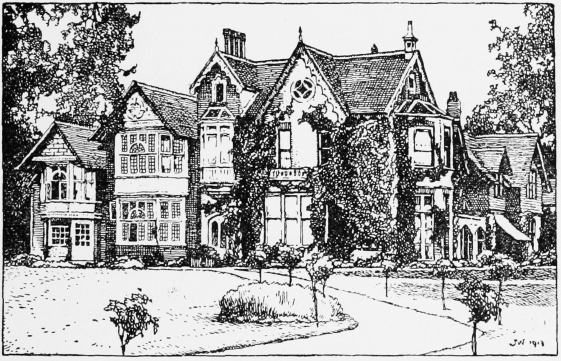
Gyldernscroft, Great Marlow
An attempt to incorporate the town was made by John Rotherham of Seymours, who by his will dated 24 September 1600 left £40 towards procuring a charter and purchasing a market. (fn. 77) No steps, however, were taken in the matter. Among the privileges exercised by the lords of the manor in Marlow was that of holding a market, (fn. 78) from which the town was sometimes called Chipping Marlow. (fn. 79) The market was established as early as 1227–8, when the town demanded that new customs should be settled by the justices of assize, the bailiffs of the Earl of Gloucester having against the custom taken ½d. from every good measure of corn sold there. (fn. 80) In 1280, however, it was stated that the Earl of Gloucester purchased the market from the king about 1260. (fn. 81) The market-place (forum) was then said to be later than the former eyre of the justices. (fn. 82) The tolls were placed out at farm by the earls, (fn. 83) but the market had lapsed before 1600, when John Rotherham left money to re-establish it. (fn. 84) This proviso never came into effect and Great Marlow appears to have remained without a market until 1780, when one held on Saturday was purchased by the ancestors of General O. L. C. Williams of Temple Park, Bisham, the owner in 1891. (fn. 85) It was said to be ill supplied before the middle of the 19th century (fn. 86) and shortly afterwards lapsed.
In addition to the market there were two fairs mentioned in the early 14th century as occurring on St. Luke the Evangelist Feast Day and Wednesday in Whitweek, (fn. 87) the latter being extended in 1525 to the two following days. (fn. 88) At the end of the 18th century these fairs were held on 29 October and 1,2,3 May, (fn. 89) but by 1813 the May fair occupied two days (fn. 90) only and had been further reduced to one day and had died out before the middle 19th century. (fn. 91) Since then only the fair for cattle on 29 and 30 October is held.
Great Marlow returned two members to the Parliaments of 1301, 1304–5, 1306, 1306–7 and 1307, (fn. 92) when the right was permitted to lapse for over 300 years. It was re-established in 1624 (fn. 93) with that of Amersham (q.v.), and two members were regularly returned until the Act of 1867 reduced the number to one. (fn. 94) The representation of the borough was, however, merged in that of the county by the Act of 1885.
The borough was wholly within the parish until 1831, when Little Marlow, Medmenham, and Bisham, Berkshire, were added. (fn. 95) The right of election was in the inhabitants paying scot and lot, the constables of the town acting as returning officers. (fn. 96)
MANORS
In the second quarter of the 11th century land at Marlow which he had purchased of his father for 250 'mancuses' of gold by weight was given by Athelstan to St. Peter. (fn. 97) GREAT MARLOW MANOR was held before the Conquest by Earl Algar and was bestowed upon Queen Maud, among whose lands it was assessed at 15 hides in 1086. (fn. 98) It became attached to her honour of Gloucester, as a part of which it was afterwards held of the Crown in chief, (fn. 99) and descended with it to Robert Fitz Hamon. (fn. 100) After his death in 1107 it was bestowed with his eldest daughter Mabel on Robert Fitz Roy, illegitimate son of Henry I, (fn. 101) created Earl of Gloucester c. 1121. (fn. 102) His son William Earl of Gloucester held Great Marlow, which passed at his death in 1183 to his eldest daughter and co-heir Mabel wife of Aumary de Montfort, Count of Evreux. (fn. 103) She is mentioned in connexion with Marlow in 1195, (fn. 104) and on her death three years later the manor descended to her son Aumary Count of Evreux. (fn. 105) On account of his resistance to King John his lands in England were forfeited, with the exception of Marlow, which was exchanged for Evreux in Normanday. (fn. 106) Aumary therefore retained the manor until his death, (fn. 107) which took place between 1210 and 1213, at which latter date his widow Millicent received one-third in dower. (fn. 108) His heir Gilbert de Clare Earl of Hertford and afterwards Earl of Gloucester, son of his mother's sister Amicia, (fn. 109) was ordered in 1217 to restore Great Marlow to Millicent and her second husband William de Cantelupe, (fn. 110) but by a subsequent arrangement Millicent renounced her rights (fn. 111) and the manor passed on Gilbert's death in 1230 to his son Richard de Clare. (fn. 112) A claim to the manor seems to have been made by Richard Plantagenet Earl of Cornwall, (fn. 113) who had married Gilbert's widow Isabel, but it was of a transitory nature and Marlow was inherited at Richard de Clare's death in 1262 by his son Gilbert Earl of Gloucester and Hertford. (fn. 114) On his marriage in 1290 with Joan daughter of Edward I Marlow was settled on them, (fn. 115) and was inherited by their son Gilbert at his mother's death in 1307. (fn. 116) He died without issue in 1314, (fn. 117) Marlow being allotted to his widow Margaret in dower, (fn. 118) but by 1316 it was the property of Hugh le Despenser, jun., called Earl of Gloucester, (fn. 119) who had married Eleanor sister and co-heir of Gilbert de Clare. (fn. 120) He remained in possession of the manor until his banishment in 1321, (fn. 121) when it was disposed of by the king, (fn. 122) but regained it on his return in the following year. (fn. 123) Notwithstanding his hanging and forfeiture in 1326, (fn. 124) Marlow was bestowed in dower in 1328 on his widow Eleanor, (fn. 125) who with her second husband, William Lord Zouche de Mortimer, alienated it in 1332 to Anthony Citeroun and Nicholas de Salvo for their lives. (fn. 126) Hugh le Despenser, her son and heir by her first husband, died without issue in 1349, leaving as heir Edward the son of his brother Edward. (fn. 127) He, who received licence in 1362 to grant to Little Marlow Priory 2 quarters of corn and 3 of barley from his manor of Marlow, (fn. 128) was succeeded in 1376 by his son Thomas, aged two, (fn. 129) during whose minority the custody was granted to John Salesbury. (fn. 130) Thomas le Despenser was beheaded in 1400 and Marlow was obtained by his widow Constance in dower, (fn. 131) although in 1405 Joan, queen of Henry IV, received the custody during the minority of Richard son and heir of Thomas le Despenser. (fn. 132) Richard having predeceased Constance, whose death took place in 1416, his sister Isabel wife of Richard Beauchamp Earl of Worcester inherited the manor. (fn. 133) As widow of her second husband, Richard Beauchamp Earl of Warwick, she made a settlement of the manor in 1439 (fn. 134) and died in the same year, leaving Marlow to her son and heir Henry Earl and afterwards Duke of Warwick. (fn. 135) At his death in 1446 he left a daughter Anne, (fn. 136) who died an infant three years later, when her father's sister Anne wife of Richard Nevill Earl of Warwick (fn. 137) inherited Marlow and also Buckland, (fn. 138) with which it descended until about 1515. In that year a twentyone years' lease of the manor was granted to Tucher Bold, (fn. 139) and in 1529 a twenty-one years' lease in reversion was obtained by William Roper. (fn. 140) Roper transferred his interest to John Daunay, (fn. 141) but in 1536, about the time of the expiration of the lease to Tucher Bold, the latter obtained another twenty-one years' lease for Thomas Bold. (fn. 142) Further complications arose on the grant in 1554 of the manor in reversion to William Lord Paget of Beaudesert. (fn. 143) The Bolds conveyed their leasehold interest to Lord Paget, (fn. 144) whereupon Bartholomew Daunay, to whom his brother John had mortgaged Marlow in 1553, (fn. 145) brought an action to recover his rights. (fn. 146) The parties arrived at a settlement, which in its turn was challenged by John Daunay on the ground that his brother had tricked him over the mortgage by absenting himself when the payment became due. (fn. 147) William Lord Paget also owned Iver (q.v.), with which Great Marlow descended (fn. 148) until 1669, when it was conveyed by William Lord Paget, son of the William who died in 1628, (fn. 149) to Thomas Moore. (fn. 150) By his will proved 24 March 1672 Thomas left his lands to his brother Robert Moore, (fn. 151) lord of the manor in 1673, (fn. 152) but it passed shortly afterwards to Sir Humphrey Winch, bart., who was already living here in 1670 (fn. 153) and who represented the borough in the Parliaments of 1679 and 1685. (fn. 154) In 1686 he sold the manor to the trustees of Lord and Lady Falkland, (fn. 155) but Lord Falkland, who was M.P. for Marlow in 1689, (fn. 156) parted with the manor in 1691 to Sir James Etheridge, kt., (fn. 157) member for Marlow from 1695 to 1713. (fn. 158) He retained the manor until 1719, (fn. 159) when it was acquired by Sir John Guise, bart., (fn. 160) member for Marlow, 1722–7. (fn. 161) After his death in 1732 (fn. 162) his son Sir John Guise, bart., acting in accordance with the terms of his father's will, (fn. 163) alienated Great Marlow in 1735 to Sir William Clayton, bart. (fn. 164) He died in 1744 (fn. 165) and his son and heir Sir Kenrick in 1769, (fn. 166) leaving a son and heir Sir Robert. (fn. 167) On the death of the latter without issue in 1799 Great Marlow was inherited by his cousin William Clayton, (fn. 168) who appears to have been recognized as heir in 1784. (fn. 169) He, who was sheriff in 1810, 1812 and 1814, (fn. 170) was succeeded in 1834 by his son Sir William Robert Clayton, bart., (fn. 171) who was member for the borough from 1831 to 1837. (fn. 172) On his death in 1866 his estates passed to his grandson Sir William Robert Clayton, bart., the present lord of the manor.
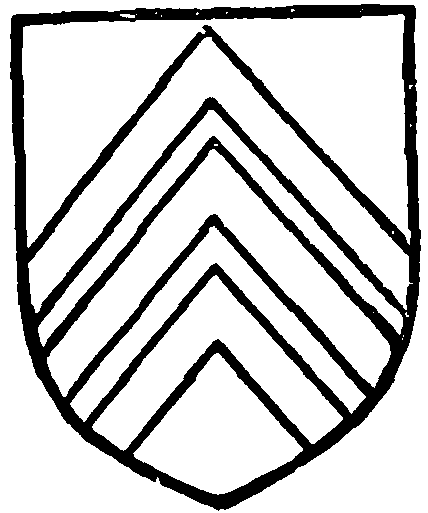
Clare. Or three cheverons gules.
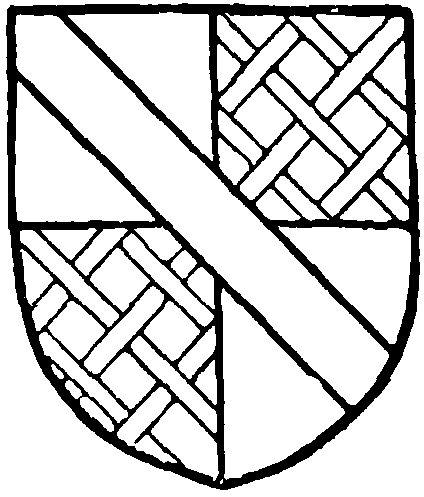
Despenser. Argent quartered with gules fretty or a bend sable over all.
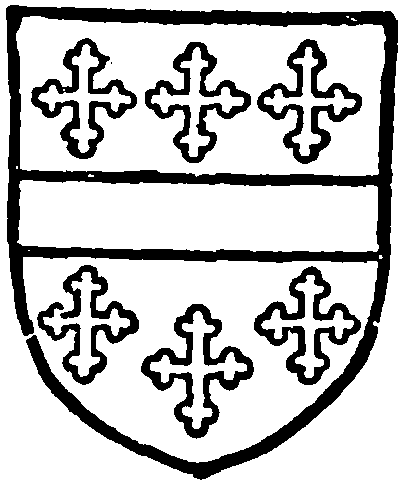
Beauchamp. Gules a fesse and six crosslets or.
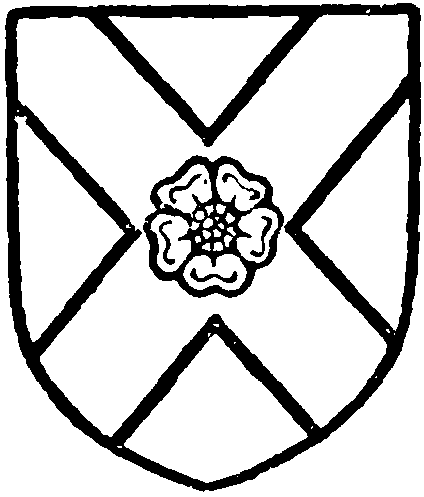
Nevill. Gules a saltire argent charged with a rose gules for difference.
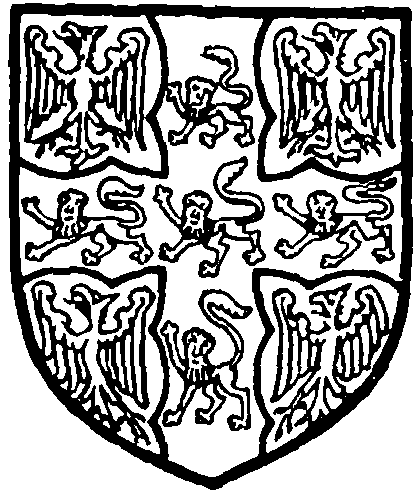
Paget of Beaudesert. Sable a cross engrailed between four eagles argent with five lions passant sable thereon.
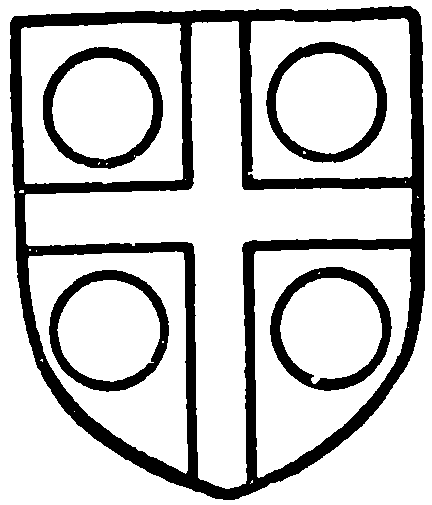
Clayton of Harleyford, baronet. Argent a cross between four roundels sable.
HARLEYFORD MANOR
HARLEYFORD MANOR in Great Marlow, which probably took its name from Hurley-ford, being opposite to Hurley, Berkshire, originated in 1 carucate of land subinfeudated before 1183 by William Earl of Gloucester, (fn. 173) of whose descendants it was afterwards held. (fn. 174) The tenure was unknown in the early 17th century. (fn. 175)
This land was obtained from Earl William by William Pincerna, whose son Humphrey maintained his right to it in 1195 against Richard son of Roland. (fn. 176) Walter Pincerna had succeeded by 1207, (fn. 177) but by 1269 this estate had passed to William de Harleyford. (fn. 178) In 1289 and 1290 William and Geoffrey de Harleyford made settlements of land in Marlow, (fn. 179) and other members of the family are John, mentioned in 1307, (fn. 180) Geoffrey, whose name occurs in 1308, (fn. 181) and Thomas, 1340. (fn. 182) A Thomas de Harleyford had lands here about 1362, (fn. 183) but the family appears to have died out and their possessions were purchased by John Flegg, who is called of Harleyford in 1464, when he was pardoned for debts incurred while escheator of Beds. and Bucks. (fn. 184) The manor so called for the first time was settled on him and his wife Agatha and their issue, but after his death was settled by Agatha on her second husband, James Cawood, for life. (fn. 185) Agatha died in 1478 (fn. 186) and James Cawood in 1481, (fn. 187) when the heirs were Agatha and Joan Lovell, daughters of Richard Lovell and Agatha, whose mother Joan, the wife of Sir Theobald Gorges, was daughter and heir to the Fleggs. (fn. 188) Agatha and Joan Lovell immediately brought an action against the feoffees, who refused to make an estate of it to them. (fn. 189) It was afterwards sold by Robert Wright to William Sandes, (fn. 190) who died in January 1492–3. (fn. 191) His son Robert called of Harleyford died in the summer of 1509, leaving as executrix his widow Margaret, (fn. 192) against whom and her second husband his son and heir John had some trouble later in establishing his claim to the estate. (fn. 193) By 1533 Edmund Lord Braye was in possession of Harleyford, (fn. 194) but conveyed it in 1536 to Tucher Bold. (fn. 195) In 1542 the latter obtained licence for a priest to officiate in his house at Harleyford on account of the distance from the parish church, (fn. 196) and in 1543 he settled the manor on himself and his wife Agnes for life with reversion to his nephew Richard Bold of Bold, Lancashire. (fn. 197) Richard Bold held Harleyford in 1556 (fn. 198) and was succeeded in 1558 by his son another Richard, (fn. 199) who made a settlement of the manor in 1571. (fn. 200) During his absence in the Low Countries his manor-house was set on fire, 1,000 marks damage being done, for which one Heywood was summoned in 1586–7 before the Privy Council. (fn. 201) In 1597 Richard Bold conveyed Harleyford Manor to Miles Hobart, citizen and clothworker of London, (fn. 202) at whose death four years later it descended to his infant son Miles, (fn. 203) who attained his majority in 1621. (fn. 204) He was knighted in 1623 and sat in Parliament 1627–8 as member for Marlow. (fn. 205) During the debate of 2 March 1629 he locked the door of the House of Commons and pocketed the key, for which action he was sent to the Tower and not released until 1631. (fn. 206) In the June of the following year he was killed by the overturning of his coach down Holborn Hill, (fn. 207) leaving as heirs his second cousins John Rous, clerk, and Margaret Holborne, wife of Oliver Ridge. (fn. 208) Harleyford was divided between them, (fn. 209) but both moieties were acquired in 1638 by William King and Ralph Chase. (fn. 210) Trouble arose through Margaret's father William Holborne having been attainted for piracy in 1592, and her moiety was said in 1640 to be in the hands of the escheator, William Lord Paget, Rous's claim being allowed in the same year. (fn. 211) Lord Paget finally obtained the manor in fee, (fn. 212) the manor-house of which became his chief residence in this parish, and it henceforward descended with his manor of Great Marlow (q.v.).
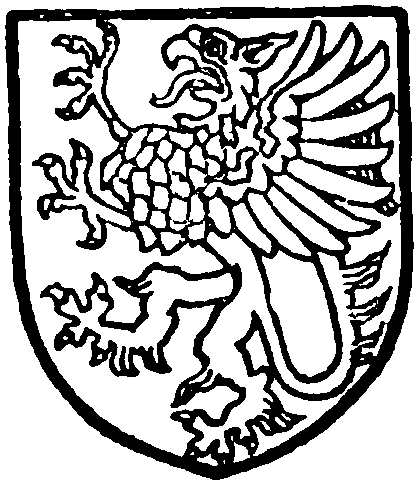
Bold of Bold. Argent a griffon sable with beak and legs or.
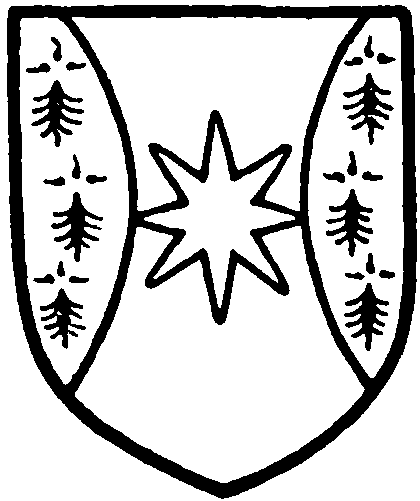
Hobart. Sable a star or between two flaunches ermine.
Six hides 1½ virgates in Marlow held formerly by Godric, a man of Asgar the Staller, were among the lands of Walter de Vernon in 1086. (fn. 213) These may have formed the nucleus of WIDMERE MANOR, the property of the Knights Hospitallers, who are mentioned first in connexion with Marlow in 1248, when the prior acquired lands in free alms from the master of St. Thomas's Hospital, Southwark. (fn. 214) The prior was accused in 1254 of neglecting to make suit at the hundred court for his land here, (fn. 215) said in 1268 to consist of a messuage, 2 carucates of land and 2s. rent in Marlow and a messuage and 2 carucates of land in Widmere. (fn. 216) Their property was augmented in 1307 at the dissolution of the Templars, (fn. 217) who had claimed view of frankpledge in 1254 from lands here and in Little Marlow mortgaged by the chief lord of the fee, by which transaction the king had suffered an inestimable loss, the Taylard family ceasing to owe foreign service to him. (fn. 218) Although it was expressly stated at this date that Widmere Manor had belonged of old to St. John of Jerusalem, (fn. 219) the acquisition of the Templar lands in Marlow caused Widmere to be described in 1338, when it was farmed at 15 marks, as the ancient property of the Templars. (fn. 220) The live stock and wool on the manor were sold in 1333 to the Bardi and Peruzzi, (fn. 221) and in 1336 the manor was leased to William de Langeford, (fn. 222) who was excused in 1339 from finding men-at-arms for the defence of Southampton. (fn. 223) In 1357 the prior, when cited by the Bishop of Lincoln to appear before the Bishop of London, ill-treated the messenger, Simon Ward, by throwing him into a stank of water at Marlow and wounding him, afterwards leading him through the town on his horse, worth 100s., whose tail and ears had been cut off. (fn. 224) Widmere Manor was leased in 1518 to William Harris for fifty-one years at £12 per annum, (fn. 225) the interest in which rent was transferred by the prior in 1539 to Sir Francis Tanfield of Gayton, Northants, who likewise obtained a thirty years' lease of the manor, dating from Michaelmas 1570, at 20s. rent. (fn. 226) A grant of Widmere in fee was made in 1541 to John Lord Russell, (fn. 227) lord of Isenhampstead Chenies (q.v.), with which it descended (fn. 228) until its alienation in 1623 by Francis Russell, Lord Russell of Thornhaugh, to Sir William Borlase, (fn. 229) lord of Little Marlow Manor (q.v.), with which Widmere descended until 1648, when a rent issuing from it appears to have been settled by Sir John Borlase, bart., on his brother William, (fn. 230) M.P. for Marlow 1659, 1660 and 1661–5, (fn. 231) who died in 1665. (fn. 232) His son John Borlase, (fn. 233) who was M.P. for Marlow 1679–81, (fn. 234) was in possession of the rent in 1679 (fn. 235) and died in 1681, (fn. 236) when his sisters and heirs, Ann wife of Thomas Wingfield, Mary, Alice and Henrietta Borlase, spinsters, (fn. 237) united with their cousin Sir John Borlase, bart., of Little Marlow, to levy a fine of the manor. (fn. 238) These four sisters, Henrietta and Alice having married Sir Richard Astley, bart., and John Wallop respectively, alienated the manor in 1687 to Richard Grenville, (fn. 239) their cousin, (fn. 240) lord of Wotton Underwood, with which Widmere descended until 1747, when it was conveyed by Richard Grenville-Temple to Daniel Moore. (fn. 241) The latter sold it in 1763 to William Clayton, (fn. 242) brother of Sir Kenrick Clayton of Great Marlow Manor and M.P. for Great Marlow in 1761, 1768, 1774 and 1780. (fn. 243) He was succeeded in 1783 (fn. 244) by his son William, (fn. 245) M.P. for Marlow 1784, (fn. 246) who inherited the title and Great Marlow on the death of his cousin Sir Robert Clayton in 1799, (fn. 247) since which date the two manors have had a similar descent.
The so-called MANOR or FARM of SEYMOURS was held by Muchelney Abbey, Somerset, before the Dissolution, and was bestowed with it on Edward Seymour Earl of Hertford. (fn. 248) In 1542 he exchanged these lands in Marlow with the king, (fn. 249) by whom they were bestowed in the same year on the Dean and Chapter of Bristol Cathedral in free alms. (fn. 250) They were held on lease under the dean and chapter (fn. 251) until about 1862, when the freehold rights were purchased by the Wethereds (see below).
A lease of Seymours had been obtained in 1541 from the Earl of Hertford by John Seymour (fn. 252) (Seamer), of whose family there is record in Marlow from the 14th century (fn. 253); this lease was confirmed to John Seymour by the dean and chapter in 1549. (fn. 254) After his death, c. 1567, trouble arose over vestments of cloth of gold worth 100 marks which had been entrusted to him as 'gardeyn or well wyller' of Marlow Church, and one cope of which had been bestowed on St. Peter's in St. Albans by his widow Alice. (fn. 255) The churchwardens brought an action in Chancery to recover them, and denied that they had been sold by the commissioners of Edward VI to Seymour. (fn. 256)
By his will Seymour had left the farm to his widow for twenty-nine years, with reversion to his executor Hugh Dawson, cook, in case of her marriage or death. (fn. 257) The lease came to Dawson, who at his death, c. 1580, left it for fifty years to his widow Katherine. (fn. 258) She afterwards married Thomas Symond, and the leasehold interest in Seymours passed to her daughter Cicely and her husband George Horde, who sold it to John Rotherham, (fn. 259) called of Seymours in 1587. (fn. 260) By his will dated 23 September 1600 Rotherham left the use of the mansion-house for two years to his wife Lettice. The Old Hall, with the 'newe buylded Garners,' the kill-house and maltinghouse and the lodging wherein his nephew William Willoughby dwelt with his children, was left to the latter, whom he made his executor. His widow and Willoughby were to have the joint use of the kitchens, ovens, cellars, ponds, &c., and after Rotherham's debts were paid the residue of the estate was to be divided among the 'poor infants' of Willoughby by his late wife Katherine. (fn. 261) John Rotherham died in December of the same year, (fn. 262) and William Willoughby inherited the lands settled upon him, among them Cublington (q.v.), with which Seymours descended until the expiration of the lease.
In 1633 two leases of Seymours were assigned by the dean and chapter to the trustees of Eleanor wife of Sir William Herbert, Lord Powis. (fn. 263) By her will dated 1650 she ordered them to be sold for the payment of her debts, but the farm was sequestered in 1652 for the delinquency of Lord Powis, (fn. 264) whose estate at Great Marlow was assessed at £140 in 1647. (fn. 265) It was afterwards discharged from sequestration and sold to John Wildman, (fn. 266) but the Powis family later recovered their rights and the lease remained in their descendants until the death of the Marquess of Powis in 1748. (fn. 267) It was then sold to Mr. Martin and descended to Mr. Johnson, in whose family it was still vested in the middle of the 19th century. (fn. 268) The estate was afterwards purchased by Mr. Thomas Owen Wethered of Remnantz, M.P. for Marlow from 1868 to 1880, (fn. 269) the present owner.
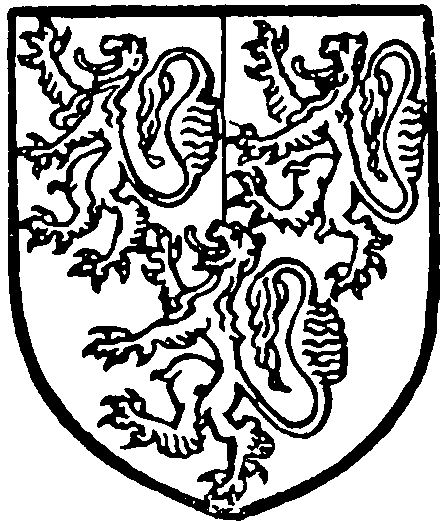
Herbert, Lord Powis. Party azure and gules three lions argent.
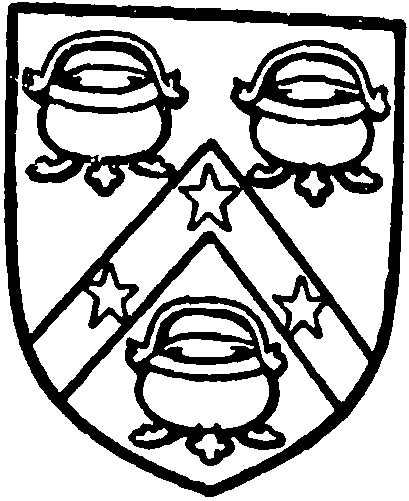
Wethered. Gules a cheveron between three fleshopts or with theree molets gules on the cheveron.
The so-called BORMER MANOR originated in 20 librates of land and quit-rent given in the early 13th century from his demesne called Bormerefield by Gilbert de Clare Earl of Hertford and Gloucester to St. Thomas's Hospital, Southwark. (fn. 270) This was assessed in 1535 at 53s. 4d. with wood there worth 10s., (fn. 271) and the capital messuage afterwards passed into the possession of Nicholas Theed, who died seised of it in 1629. (fn. 272) Bormers is marked as a farm on a map dated 1796, (fn. 273) but the name is now spelt Barmoor.
The most important item of the hospital's estate in Great Marlow consisted of three mills called Gosenham Mills, one of which, however, is sometimes spoken of as Harleyford Mill. This was probably situated furthest west near the present Harleyford Mill, while the other two would lie towards the east, where there are now two mills, adjoining which on the east is meadow land called Gosmer, probably the modern form of Gosenham. (fn. 274) Two of these were bestowed in the middle 13th century by Geoffrey de Marlow, clerk, in return for several bushels of grain. (fn. 275) Geoffrey's ancestor Matthew de Marlow had received them at the beginning of the century from the Earl of Gloucester, and in 1227 he gained a suit brought against Walter Sealy and Ellis de la Launde for neglecting to do service there for the four past years. (fn. 276) Fresh arrangements concerning the payment of grain were made in 1269 (fn. 277) and 1277, at which latter date Geoffrey son of John de Marlow took 12 quarters of the best corn yearly. (fn. 278) John obtained in addition the remission of toll for grinding his corn and right of fishing near his land, for which 6 silver marks and 1d. (fn. 279) were paid. The sum was still owing in 1298, when John's widow Alice was ordered to pay 40s. a year until the debt was paid. (fn. 280) The third mill was given to Southwark Hospital by Richard de Clare Earl of Hertford and Gloucester, who at the same time confirmed Geoffrey de Marlow's gift, (fn. 281) but in 1315 Gilbert de Clare, the then earl, acquired the three mills from the hospital in exchange for lands, &c., elsewhere. (fn. 282) Matthew Miller obtained a lease from the earl at 14 marks yearly, of which one was to go to the canons of Missenden, (fn. 283) but the hospital evidently recovered the two mills given by Geoffrey de Marlow, as only one was included in Great Marlow Manor in 1416, (fn. 284) and a lease of the other two was made in 1362 to Thomas Pynell by the Prior of St. Thomas's. Thomas was to pay 5s. for life and his heirs 10s. (fn. 285) This latter rent probably accounts for the 10s. in Gosenham credited to the hospital at the valuation of 1535, other property there being assessed at 6s. 8d. (fn. 286) In 1560 John Brinkhurst received a lease of a mill here, (fn. 287) but by 1609 these two mills with Gosenham Meadow and plots of osiers were in the possession of Thomas Farmer, at whose death in that year they descended to his son John. (fn. 288) On account of his recusancy, however, they were granted for forty-one years to Sir Richard Coningsby. (fn. 289) John Farmer died in 1631, and the water-mills, said to be three, passed to his son John, (fn. 290) whose estate in Marlow, as that of a Papist, was returned in 1647 at £124. (fn. 291)
Four mills in Great Marlow were in the possession of John and Mary Ferrers in 1723, (fn. 292) and by 1797 there were corn and paper-mills on the river, (fn. 293) which exist at the present day.
Leland, writing in the early 16th century, speaks of two mills at Marlow, one for making linseed oil and the other 'erected for the machinery of thimbils.' (fn. 294) The thimble-mill was afterwards the property of John Lofting, a manufacturer and inventor of fire engines, who settled here in the early 18th century. One of his seven sons founded the charity now called 'Loftin's' charity. (fn. 295)
CHURCHES
The church of ALL SAINTS consists of a chancel, nave with aisles and a western tower with a lofty spire.
It was built in 1832 in place of an earlier church, of which the tower and spire fell on 21 December 1831. (fn. 296) This church contained, among other fittings, at least three beautiful brasses, which were destroyed. Rubbings of these, however, are preserved in the Craven Ord collection at the British Museum and in the Franks collection at the Society of Antiquaries. One of these, to William, John, Louis, and John, four sons of Sir John and Dame Joan Salesbury, who died in 1383–8, was extremely fine; in the upper part was represented the Resurrection, and below the kneeling figures of the sons in adoration with a shield of Salesbury, all within a marginal inscription with the symbols of the Evangelists at the corners. Another was to John Warner, rector, who died in 1421, and included a figure of a priest in mass vestments and part of a marginal inscription. A third included two priests in mass vestments of about 1450 and an inscription on one slab. Besides these there were some other inscriptions and fragments.
Several monuments from the former church have been refixed in the present building. In the south aisle is an alabaster and marble monument to Katherine wife of William Willoughby, 1597, with figures of themselves and their family. On the west wall of the narthex is a monument to Sir Miles Hobart, kt., erected by Parliament in 1640; he died in 1632 as the result of a coach accident, which is represented on the tomb. A monument with shields of arms in the north aisle is to William Horsepoole of Gray's Inn, 1642, his wife Mary daughter and heir of Lawrence Washington, 1644, two daughters and four grandchildren. There is also a tablet to the Rev. Thomas Langley, the author of the History of Desborough Hundred, stating that he died in 1801 at the early age of thirty-two. (fn. 297) In the vestry is a curious picture painted by Coventry of a black and white spotted boy who died in 1812. His master, John Richardson, spent his early years in a workhouse here, but afterwards amassed a considerable fortune as an itinerant showman. (fn. 298) A stone in the churchyard marks his burial in the same grave as the spotted boy.
The tower contains a ring of eight bells, the treble and tenor by Thomas Mears, dated 1834, the second also by Thomas Mears, 1827, the third, fourth, fifth, sixth and seventh by R. Phelps, 1719. There is also a sanctus bell of 1694 by Samuel Knight of Reading.
The plate includes a perforated stand paten of 1619 given by Christiana Haward, a cup and stand paten of 1629 and a cup and stand paten of 1634. The two later cups and patens have the initials R.C. (for Ralph Chase) and the date 1629 engraved on them.
The registers begin in 1592.
The church of HOLY TRINITY, Marlow, consecrated in 1852, is built of flint with stone dressings, and consists of chancel, nave, north aisle, south porch and a turret containing one bell. The living is held with that of All Saints.
The ecclesiastical parish of HOLY TRINITY, Lane End, was formed in 1867. (fn. 299) The church, which was rebuilt in 1878 from designs by J. O. Scott on the site of the former building erected about 1832, is of brick and flint with Bath stone dressings in 13th-century style. It consists of chancel, nave, vestry, organ chamber, north porch and a tower containing six bells. The nave roof, which is of sessile oak and of 13th-century date, was brought from the tithe barn near Marlow Bridge. The living is a vicarage in the gift of the rector of Hambleden.
ADVOWSON
Marlow Church was appurtenant to the manor and was bestowed by Robert Fitz Hamon on Tewkesbury Abbey, (fn. 300) Henry I confirming the gift after the death of Robert in 1107. (fn. 301) It was seized by John in 1203 on pretext of a vacancy in the abbacy, (fn. 302) and Stephen Ridel resigned in favour of William de Necton, though he was granted a pension of 1 bezant in compensation. (fn. 303) In 1221 the abbey received from the pope an indult to re-enter the church when void and to present fit vicars. (fn. 304) A forced vacancy occurred in 1234, when all the clerks in England of Roman nationality were deprived of their benefices, and Michael de Spinevile was presented by Tewkesbury. (fn. 305) The church was confirmed to the monks by Hugh Bishop of Lincoln, (fn. 306) but his successor, Robert Grosteste, treated them very harshly when they sought to appropriate the church in 1241 on the death of Nicholas de Spinevile, (fn. 307) and though the abbot was permitted to present William de Staneway, a pension of 26 marks was to be paid in compensation for the benefice to Gilbert de Clare, pupilli, until other provision should be made for him. (fn. 308)
All right in the church was finally renounced by the abbot in 1247 to Richard de Clare Earl of Gloucester, lord of the manor, (fn. 309) with which the advowson henceforward descends. (fn. 310) On the partition of the Earl of Warwick's land in 1472 it was obtained by his daughter Anne and her husband Richard Duke of Gloucester, (fn. 311) who in 1477 received licence to alienate it among others to found a college for a dean and twelve priests. (fn. 312) This intention seems to have proved abortive, for in 1494 Henry VII granted the advowson in free alms to Tewkesbury Abbey, (fn. 313) by whom it was retained until the Dissolution. The church had been assessed at £33 6s. 8d. in 1291, (fn. 314) and in 1535 the vicarage was said to be worth £13 6s. 8d. (fn. 315) and the farm of the rectory £20 3s. 4d. (fn. 316) £4 16s. 8d. of the latter sum was annually divided among the poor on 18 February in accordance with an order of George Duke of Clarence and his wife Isabel, dating from the appropriation of the church. (fn. 317)
In 1541 a grant of Great Marlow rectory and church was made to the Dean and Chapter of Gloucester Cathedral, (fn. 318) by whom the advowson was retained until 1855, (fn. 319) when it became the right of the Bishop of Oxford, (fn. 320) the present patron.
Among the leases of the rectory granted from time to time (fn. 321) was one given in 1520 to John Sandys for the longest life of himself and sons. (fn. 322) At his death in 1552 he left it to his son Thomas, (fn. 323) to whom also was left in 1567 the interest of John Seymour, (fn. 324) who in 1549 had obtained a sixty years' lease in reversion. (fn. 325) Another reversionary lease had been granted in 1553 to John Apercharde, of whom it was purchased by William Newberry and Richard Langley. (fn. 326) In 1602 the dean sued the two latter for wrongful entry into the premises, but the defendants were successful. (fn. 327) The Langleys' moiety was the cause of a quarrel in 1626 between two Richard Langleys, son and grandson respectively of the said Richard, who had died in 1612. (fn. 328)
The rectorial tithes have been commuted and are now vested in the Ecclesiastical Commissioners.
The first reference to the chantry of the Blessed Virgin Mary in Great Marlow Church dates from 1387, when the burgesses presented (fn. 329); a further presentation in 1394 records that the patronage had been vested in them from time immemorial. (fn. 330) At the dissolution of the chantries in 1547 it was valued at £10 6s. 10d., whereof the priest, Sir James Gray, received £6 13s. 4d. as salary. He was 'allowed to teach children and to help to minister in the quier,' since the parish was 4 miles long with a compass of 17 to 18 miles (fn. 331); 13s. had been paid to '2 poor foulks' for seven years past because 'thei be verie olde, ympotent, poor and not able to paie their rents.' (fn. 332) Grants of the possessions of the dissolved chantry were made in 1549, (fn. 333) 1585, (fn. 334) 1593 and 1600, (fn. 335) and in 1607 the chantry was obtained in fee by Sir John Ramsey, kt. (fn. 336)
Lands and rents in Great Marlow worth 37s. yearly were given for an obit, and others worth 9s. sustained a lamp in the church. (fn. 337)
CHARITIES
The united charities are regulated by a scheme of the Charity Commissioners of 21 December 1895 and are administered by one body of trustees. They comprise the charities of:—
William Willoughby, founded by will, proved in the P.C.C. 23 January 1587–8, consisting of a rentcharge of £8 6s. 8d. receivable every fifth year out of certain lands in the county of Nottingham and applicable in gifts of £1 to each of six poor men, 10s. to each of four poor women, and 6s. 8d. to the vicar.
Robert Boothby, founded prior to 1610, being a rent-charge of 10s. issuing out of land near the market-place, distributed in sums of 1s. to each of ten poor persons.
Agnes Fryar, will 1615, being a rent-charge of 20s. out of two cottages in West Street, distributed in sums of 1s. to each of twenty of the poorest women.
The Turville charity, founded by deed 1613, by Sir William Willoughby and others, consisting of an annuity of £10 issuing out of Northend Farm in the parish of Turville, applied with the income of the poor's estate (see below).
Thomas Drew, will 1651, being a rent-charge of £2 12s. out of tenements in West Street, applied in the distribution of bread among twelve aged poor persons every fortnight.
Henry Pendleton, will prior to 1675, being an annual payment of £1 out of the income of the poor's estate applied in gifts of 1s. each to twenty oldest and poorest persons.
The poor's estate.
The trust property consists of 4 acres in Marlow Field where race meetings were formerly held, 6 acres at Bovingdon Green, 6 acres, or thereabouts, of allotment land, and four cottages and gardens at Berwicks, the gross rental value being £76 a year; also a sum of £1,981 13s. 10d. consols, producing £49 10s. 8d. yearly. The income is applicable under the provisions of a scheme of 14 June 1872 for the general benefit of the poor. In 1909 the net income, amounting to about £100, was applied in the distribution of thirty-six tickets for beef, 144 sacks of coal and 580 drapery tickets.
Richard Davenport, as mentioned on a tablet in the church, dated 1798, (fn. 338) by will charged his estates with £5 per annum, to be paid to five poor widows. The annuity was redeemed in 1904 by the transfer to the official trustees of £200 consols.
The Rev. John Cleobury, a former vicar, as recorded in the churchwardens' book, 1799, gave £100 stock, now £100 consols. In 1909 the dividends were applied as to £2 2s. in flannel garments to old men and women, 5s. to the parish clerk and 3s. in money.
Mrs. Sarah Hawes, who died in 1799, by will bequeathed £100 stock, now £100 consols, the dividends to be expended in shoes and stockings amongst children regularly attending Sunday school.
Sarah Wethered, deed 6 December 1852, trust fund, £700 consols, the dividends of £17 10s. to be applied in the distribution of beef on Christmas Eve among poor widows and widowers. In 1909 167 tickets for beef were so distributed.
Susanna Hone, for poor, deed 10 September 1853, trust fund, £90 14s. 2d. consols, producing £2 5s. 4d. a year, to be distributed at Christmas among twelve poor men and twelve poor women, applied in the purchase of hose for the same.
Susanna Hone's educational foundation by same deed, trust fund, £100 consols, annual dividends of £2 10s. to be applied in the distribution of stockings at Christmas to deserving girls and boys attending Sunday school.
The Oxford Lane Almshouses, founded by John Brinkhurst by deed 20 July 1608, are regulated by a scheme of the Charity Commissioners of 9 August 1907. The trust property consists of eight almshouses for eight poor people and a sum of £5,139 9s. 11d. consols, producing an income of £128 9s. 8d. a year, arising as to £3,196 14s. 7d. stock from sales of land and of a public-house and cottages in St. Peter's Street and accumulations of income, and as to £1,942 15s. 4d. stock from an augmentation by will of James Rolls, proved in 1874. Each of the inmates receives not less than 3s. 6d. per week or more than 5s. The stock is held by the official trustees, who also hold a sum of £108 5s. 1d. India 3 per cent. stock as a repair fund, being a gift in 1906 by Gen. Sir George Wentworth Alexander Higginson, G.C.B., in memory of his deceased sister, Miss Frances Alicia Higginson.
In 1874 Ann West by will, proved at London 14 March, bequeathed £100 consols, the income (subject to the keeping in repair the tomb of herself and her husband in Trinity Church) to be distributed equally among six poor widows.
In 1875 Thomas Rolls by will, proved at London 31 March, bequeathed a legacy now represented by £53 3s. 8d. consols, the dividends, amounting to £1 6s. 4d., to be distributed equally among six poor men.
In 1877 Joseph Henry Rolls by deed 22 May gave £200 consols, the dividends of £5 to be divided on 24 January yearly between twelve poor persons of the age of sixty years and upwards.
The recreation ground, comprised in an award of the Inclosure Commissioners 13 September 1855, (fn. 339) consists of 5 acres of land, producing £3 10s. yearly, and a sum of £246 5s. 9d. consols, arising from accumulations of income; the annual dividends, amounting to £6 3s., are with the income derived from the land applied towards the relief of the rates. The charity is regulated by a scheme of the Charity Commissioners of 30 January 1900.
Educational and apprenticing charities.
The free school was founded in 1624 by Sir William Borlase, kt., of Medmenham. (fn. 340)
The Islington charity.
William Drew by his will, proved in the P.C.C. prior to 1651, devised an annuity of £10 payable out of his estate in Islington for the use of the poor, which, together with the dividends on £71 0s. 4d. representing accumulations of income, is applied in apprenticing poor boys.
In 1759 William Lofting by deed dated 10 December conveyed to trustees a farm known as Copy Green Farm, containing 80 acres, or thereabouts, now let at £50 a year, the rents to be applied in apprenticing poor children. The trustees also hold a sum of £427 consols, producing £10 13s. 4d. a year, arising from the sale of timber. The income is duly applied in the payment of apprenticeship premiums.
This parish also participates in the distribution of Bibles and other religious books under the charity of Philip Lord Wharton.
In 1875 Miss Jemima Anne Cocks by her will, proved at London 3 May, bequeathed a legacy, now represented by £333 6s. 8d. conso's, the dividends, amounting to £8 6s. 8d., to be applied for the benefit of the infants' school.
The several sums of stock, unless otherwise stated, are held by the official trustees.
